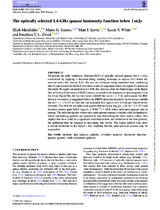| dc.contributor.author | Malefahlo, Eliab | |
| dc.contributor.author | Santos, Mario G. | |
| dc.contributor.author | Jarvis, Matt J | |
| dc.contributor.author | White, Sarah V. | |
| dc.contributor.author | Zwart, Jonathan T. L. | |
| dc.date.accessioned | 2021-02-09T10:10:13Z | |
| dc.date.available | 2021-02-09T10:10:13Z | |
| dc.date.issued | 2020 | |
| dc.identifier.citation | Zwart, J et al. (2020) The optically selected 1.4-GHz quasar luminosity function below 1 mJy. Monthly Notices of the Royal Astronomical Society, V492 I4, pgs 5297–5312,DOI: 10.1093/mnras/staa112 | en_US |
| dc.identifier.other | DOI: https://doi.org/10.1093/mnras/staa112 | |
| dc.identifier.uri | http://hdl.handle.net/10566/5874 | |
| dc.description.abstract | We present the radio luminosity function (RLF) of optically selected quasars below 1 mJy, constructed by applying a Bayesian-fitting stacking technique to objects well below the nominal radio flux density limit. We test the technique using simulated data, confirming that we can reconstruct the RLF over three orders of magnitude below the typical 5σ detection threshold. We apply our method to 1.4-GHz flux densities from the Faint Images of the Radio Sky at Twenty-Centimeters (FIRST) survey, extracted at the positions of optical quasars from the Sloan Digital Sky Survey over seven redshift bins up to z = 2.15, and measure the RLF down to two orders of magnitude below the FIRST detection threshold. In the lowest redshift bin (0.2 < z < 0.45), we find that our measured RLF agrees well with deeper data from the literature. The RLF for the radio-loud quasars flattens below log10[L1.4/WHz−1]≈25.5 and becomes steeper again below log10[L1.4/WHz−1]≈24.8, where radio-quiet quasars start to emerge. The radio luminosity where radio-quiet quasars emerge coincides with the luminosity where star-forming galaxies are expected to start dominating the radio source counts. This implies that there could be a significant contribution from star formation in the host galaxies, but additional data are required to investigate this further. The higher redshift bins show a similar behaviour to the lowest z bin, implying that the same physical process may be responsible. | en_US |
| dc.language.iso | en | en_US |
| dc.publisher | Oxford University Press | en_US |
| dc.subject | Methods: Data analysis | en_US |
| dc.subject | Galaxies: Evolution | en_US |
| dc.subject | Galaxies: Luminosity function | en_US |
| dc.subject | Quasars: General | en_US |
| dc.subject | Radio continuum: Galaxies | en_US |
| dc.title | The optically selected 1.4-GHz quasar luminosity function below 1 mJy | en_US |
| dc.type | Article | en_US |

